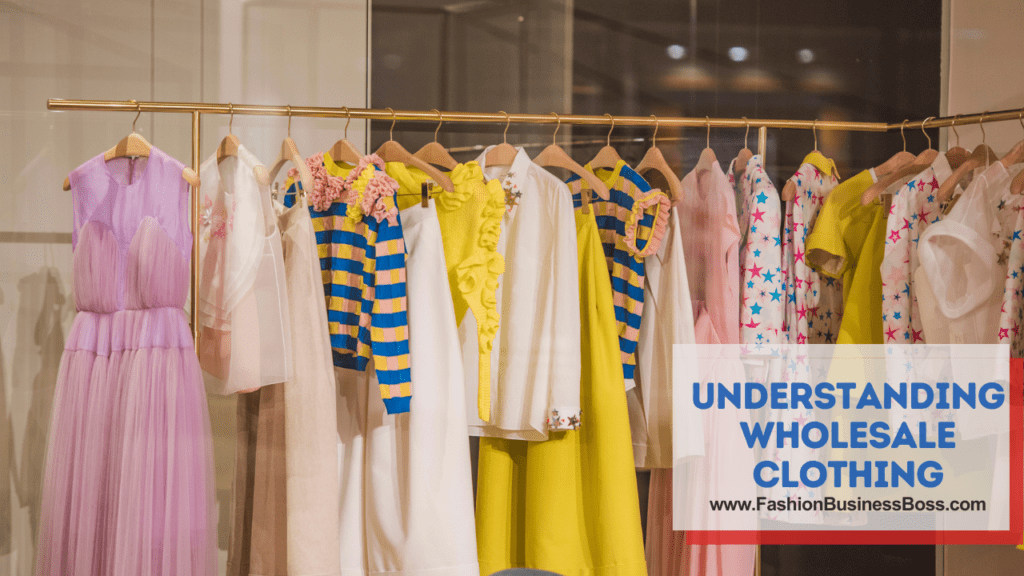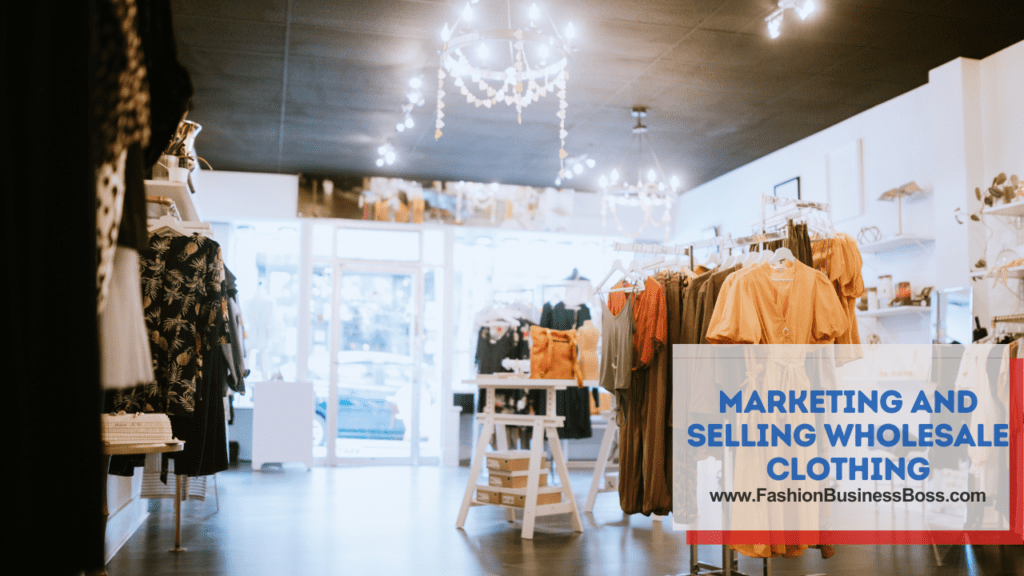In the world of fashion and retail, boutiques hold a unique place. They offer curated collections that cater to niche markets, providing customers with a personalized shopping experience. One key factor that contributes to the stability of a boutique is the selection of clothing.
To grow in the boutique business, sourcing wholesale clothing is essential. Find unique pieces, negotiate prices, and curate a stunning collection that keeps customers coming back for more.
In this article, we’ll explore the ins and outs of wholesale clothing for boutiques.
Understanding Wholesale Clothing
What Is Wholesale Clothing?

Wholesale clothing refers to buying clothes in large quantities at lower prices from suppliers or manufacturers. This practice allows boutique owners to stock a wide variety of clothing items to offer their customers.
Benefits of Wholesale Clothing for Boutiques
Wholesale clothing offers several advantages to boutiques. First, it allows them to purchase clothing at a lower cost per item, which can increase their profit margins. Second, it provides access to a diverse range of styles and sizes, catering to a broader customer base. Buying in bulk ensures consistent inventory, reducing the risk of running out of popular items.
Read more about: 13 Tips and Tricks For a Thriving Clothing Boutique
Types of Wholesale Clothing Suppliers
Wholesale clothing suppliers come in various forms:
Manufacturers: These companies produce clothing and sell it directly to retailers.
Distributors: They purchase clothing in bulk from manufacturers and resell it to boutiques.
Wholesalers: These businesses buy clothing in large quantities and offer it to retailers at competitive prices.
By understanding these basics of wholesale clothing, boutique owners can make informed decisions to enhance their inventory and satisfy their customers’ fashion needs.
Sourcing Wholesale Clothing
Researching Suppliers: Tips and Tricks
When sourcing wholesale clothing for your boutique, thorough research is essential. Start by identifying potential suppliers through online searches, industry directories, or referrals from fellow boutique owners. Look for suppliers with a good reputation for reliability and quality.
Once you’ve identified potential suppliers, delve deeper into their background. Check their track record, customer reviews, and years in business. This step helps you gauge their credibility and trustworthiness.
Negotiating Prices and Terms
Effective negotiation with wholesale clothing suppliers is a critical skill. When discussing prices and terms, be clear about your expectations. Ask about minimum order quantities, payment terms, and delivery schedules. Always aim for a fair deal that aligns with your budget and business goals.
Quality Assurance: Inspecting Your Stock
Maintaining the quality of your inventory is vital. Before finalizing any wholesale clothing purchase, inspect samples or request product samples. This allows you to assess the quality of the clothing items, ensuring they meet your boutique’s standards.
By following these tips and tricks for researching suppliers, negotiating effectively, and conducting quality assurance checks, you’ll be better equipped to source high-quality wholesale clothing for your boutique, providing your customers with the best shopping experience possible.
Building Your Boutique’s Unique Collection
Finding Your Niche
To create a standout collection for your boutique, start by finding your niche. A niche is a specific area or category within the fashion world that you want your boutique to specialize in. This could be anything from vintage clothing to sustainable fashion or athleisure wear. By focusing on a particular niche, you can cater to a specific group of customers who share similar interests and tastes.
Seasonal Trends and Timeless Classics
When curating your boutique’s collection, consider both seasonal trends and timeless classics. Seasonal trends are the styles that are currently popular and in-demand. Timeless classics, on the other hand, are wardrobe staples that never go out of style. A balanced mix of both ensures that your collection remains relevant and appeals to a wide range of customers.
Creating a Cohesive Brand Image
A cohesive brand image is essential for your boutique. It means that all the clothing items you offer should align with your boutique’s overall style and message. This consistency helps customers recognize your brand and builds trust. When selecting clothing for your collection, ensure that each piece fits within your brand’s aesthetic and vision.
By finding your niche, incorporating seasonal trends and timeless classics, and maintaining a cohesive brand image, you can build a unique and appealing collection for your boutique. This approach will attract customers who resonate with your style, ultimately contributing to your boutique’s growth.
Marketing and Selling Wholesale Clothing
Pricing Strategies

Pricing is a crucial aspect of marketing and selling wholesale clothing. It involves determining how much you’ll charge for the clothing items you offer in your boutique. To set the right prices, consider factors like the cost of goods, competitor pricing, and your target customers’ willingness to pay. Your goal is to find a pricing strategy that allows you to cover your costs while offering value to your customers.
Visual Merchandising
Visual merchandising is the art of presenting your wholesale clothing in an appealing way to attract customers. This includes arranging clothing displays, choosing appropriate lighting, and using signage effectively. A well-organized and visually pleasing boutique can create a positive shopping experience and encourage customers to make purchases.
Online vs. Brick-and-Mortar Sales
Deciding between online and brick-and-mortar sales is a crucial choice for your boutique. Online sales offer a broader reach, while brick-and-mortar stores provide a tangible shopping experience. Consider your target audience and budget when making this decision. Some boutiques choose to have a presence both online and offline to cater to different customer preferences.
Read more about: Apparel Ambitions: A Clothing Brand Startup
Managing Inventory and Stock
Inventory Management Software
Inventory management is a crucial part of running a boutique. It involves keeping track of the clothing items you have in stock and ensuring that you have the right quantity on hand to meet customer demand. Inventory management software is a valuable tool that can help you keep accurate records of your stock levels. It tracks when items are sold and when new stock needs to be ordered. This way, you can avoid overstocking or running out of popular items.
Stocking for Different Seasons
Seasonal variations in fashion are common, and it’s important to plan your inventory accordingly. For example, in the summer, you’ll want to stock lightweight and summery clothing, while in the winter, you’ll need warmer options. Anticipating these changes in customer preferences and adjusting your inventory accordingly ensures that you have the right clothing available at the right time.
Handling Returns and Exchanges
Dealing with returns and exchanges is part of the retail business. It’s essential to have a clear and customer-friendly return policy in place. When customers want to return or exchange items, be prepared to handle these requests promptly and courteously. This builds trust and goodwill with your customers.
Customer Relations
Providing Exceptional Customer Service
Exceptional customer service is the foundation of a thriving boutique. It means treating your customers with kindness, respect, and attentiveness. When customers enter your store or shop online, they should feel welcome and valued. Attend to their needs promptly, answer their questions, and assist them in finding the clothing items they desire. A positive shopping experience encourages repeat visits and word-of-mouth recommendations.
Collecting and Using Customer Feedback
Feedback from your customers is a valuable resource. Encourage customers to share their thoughts and opinions about their experiences with your boutique. Whether it’s through surveys, reviews, or in-person conversations, gather feedback to understand what you’re doing well and where you can improve. Use this feedback to make informed decisions and enhance your boutique’s offerings and services.
Loyalty Programs and Customer Retention
Loyalty programs are an effective way to retain customers. These programs reward repeat customers with discounts, exclusive offers, or other incentives. They encourage customers to return to your boutique, fostering a sense of loyalty. By nurturing ongoing relationships with your customers and showing appreciation for their loyalty, you can create a loyal customer base that continues to support your boutique.
Legal Considerations
Licensing and Permits

When operating a boutique, it’s important to comply with legal requirements such as licensing and permits. These are official permissions from government authorities that allow you to run your business legally. To get the necessary licenses and permits, you’ll need to follow the regulations specific to your location and industry. It’s crucial to research and understand the requirements in your area and ensure that you obtain the proper documentation to avoid legal issues.
Contracts with Suppliers
Contracts with suppliers are essential for clarifying the terms of your business relationships. These contracts outline details such as pricing, payment terms, delivery schedules, and product quality standards. They serve as legally binding agreements that protect both you and your suppliers. It’s advisable to have clear and comprehensive contracts in place with your suppliers to prevent misunderstandings and disputes down the road.
Read more about: Behind the Seams: Calculating Clothing Manufacturing Costs
Compliance with Consumer Protection Laws
Consumer protection laws exist to safeguard the rights and interests of your customers. These laws set guidelines for fair business practices, product safety, and customer rights. It’s crucial to be aware of and comply with these laws to ensure that your boutique operates ethically and legally. Violating consumer protection laws can result in legal troubles and damage to your boutique’s reputation.
Conclusion
Wholesale clothing for boutiques is a dynamic and fulfilling venture that presents boutique owners with a wealth of opportunities. It enables them to curate distinctive collections, provide competitive pricing, and remain at the forefront of the constantly evolving fashion landscape. By delving into the complexities of sourcing, marketing, and inventory management, you can strategically position your boutique for sustainable growth.
With dedication, sound business practices, and a deep understanding of the wholesale clothing ecosystem, your boutique can not only endure but also flourish in this competitive world. So, embrace the challenges and opportunities that come your way, and continue to make your mark in the world of boutique fashion.
Frequently Asked Questions

Q: What is wholesale clothing for boutiques?
A: Wholesale clothing for boutiques involves purchasing clothing items in bulk from suppliers, enabling boutique owners to curate diverse collections and offer a wide range of fashion choices to their customers.
Q: How can reliable wholesale clothing suppliers be found?
A: Reliable wholesale clothing suppliers can be found through thorough research, attending trade shows, and seeking recommendations from industry peers. Evaluation criteria typically include reputation, pricing, and product quality.
Q: What key factors should be considered when negotiating with wholesale clothing suppliers?
A: When negotiating with wholesale clothing suppliers, key factors to consider include pricing, minimum order quantities, payment terms, and delivery schedules. Effective negotiation can lead to favorable deals.
Q: How can boutique inventory be managed effectively?
A: Effective boutique inventory management involves using inventory management software, forecasting demand, and categorizing items by season and style. Regular monitoring of stock levels and sales data analysis are essential for optimization.
Q: What legal aspects should be taken into account when dealing with wholesale clothing?
A: Boutique owners should be aware of legal requirements such as licensing and permits, supplier contracts, and compliance with consumer protection laws when dealing with wholesale clothing. Seeking legal advice may be advisable for ensuring compliance.
To learn more about starting your own clothing business, check out my startup documents here.
The information provided by FashionBusinessBoss.com (“The Site”) is for general informational purposes only. All information on the Site is provided in good faith, however, we make no representation or warranty of any kind, express or implied, regarding the accuracy, adequacy, validity, reliability, availability or completeness of any information on the Site. Under no circumstance shall we have any liability to you for any loss or damage of any kind incurred as a result of the use of the Site or Reliance on any information provided on the Site. Your use of the Site and your reliance on any information on the Site is solely at your own risk. This blog post is for educational purposes only and does not constitute legal advice. Please consult a legal expert to address your specific needs. Terms and Conditions. (https://fashionbusinessboss.com/terms-and-conditions/)

Meet Shawn Chun: Entrepreneur and Fashion Business Fan.
I’m a happy individual who happens to be an entrepreneur. I have owned several types of businesses in my life from a coffee shop to an import and export business to an online review business plus a few more and now I create online resources for those interested in starting new ventures. It’s demanding work but I love it. I do it for those passionate about their business and their goals. That’s why when I meet a designer or boutique owner at a craft fair, farmers market, retail location or anywhere else I see myself. I know how hard the struggle is to retain clients, find good employees and keep the business growing all while trying to stay competitive.
That’s why I created Fashion Business Boss: I want to help fashion business owners like you build a thriving business that brings you endless joy and supports your ideal lifestyle.

